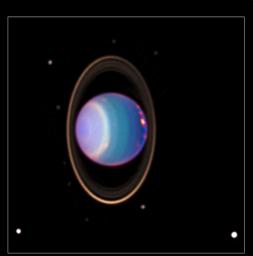August 2005
Scott Mair
They're big; they're cold; they're gassy
and August is the best time this year to look for them. Say
hi to Uranus and Neptune. Both planets will be at opposition
(with the Earth directly between the planet and the Sun) in
August: Neptune on the 7th; Uranus on the 31st. That means
they're as about as close as they get to the Earth. Mind you
that's still pretty far away: Uranus will be about 2.7
billion kilometers from the Earth; and Neptune 4.35 billion
kilometers away.
 Uranus
was the first planet to be found in the modern era,
discovered by William Herschel on March 13, 1781 (all the
other planets at that time from Mercury to Saturn had
been known from ancient times). Uranus had actually been
seen many times before, but ignored as simply another star.
Herschel was the first to recognize it as a planet.
Uranus
was the first planet to be found in the modern era,
discovered by William Herschel on March 13, 1781 (all the
other planets at that time from Mercury to Saturn had
been known from ancient times). Uranus had actually been
seen many times before, but ignored as simply another star.
Herschel was the first to recognize it as a planet.
You'd think that if you discovered a planet you'd get to
name it but, not the case for Herschel. He wanted to call
it, George (actually, Georgium Sidus the Georgian Planet).
I guess it was too clearly a case of sucking-up (George was
the King of England at the time) so most of his friends
called it planet Herschel. Apparently though, naming
something as important as a planet after the discoverer is
just not done in 18th century England. Herschel's second
choice was to call the planet Neptune, but that didn't take
either. Eventually the community of astronomers agreed on
Uranus which just goes to show that planets should never be
named by committee - no matter how much 10 year-old boys
like saying "your anus".
Something catastrophic seems to have happened to Uranus,
because it is the only planet in the solar system that spins
on its side as if it was struck by a massive object early in
its life, Thanks to the Voyager 2 spacecraft we also know
that Uranus (and Neptune, too) has rings like Saturn.
NASA's Solar System Exploration Planets Uranus Overview
NASA's Solar System Exploration Planets Neptune Overview
 Neptune
has the distinction of being the first planet whose presence
was predicted before it was actually discovered. Some
weirdness in the way Uranus travels around the Sun suggested
that the gravity of an unknown planet was affecting Uranus's
orbit. After some clever calculations by French and English
astronomers Neptune was discovered by the Galle and d'Arrest
on September 23, 1846.
Neptune
has the distinction of being the first planet whose presence
was predicted before it was actually discovered. Some
weirdness in the way Uranus travels around the Sun suggested
that the gravity of an unknown planet was affecting Uranus's
orbit. After some clever calculations by French and English
astronomers Neptune was discovered by the Galle and d'Arrest
on September 23, 1846.
It's only through bad luck that Neptune wasn't discovered by
Galileo 233 years earlier. He saw Neptune while observing
Jupiter in 1613 and thought it was a star. Although he
noticed some movement of the 'star' on subsequent nights it
wasn't enough to confirm it as a planet before it was out of
his field of view. If the previous days hadn't have been
cloudy Galileo would certainly have noticed the relative
movement of Neptune and identified it as a planet.
If you want to see Neptune and Uranus for yourself point
toward Aquarius for Uranus and Capricorn for Neptune. You'll
need binoculars or a telescope and a good star chart, but
with a little imagination you might just feel the presence
of Herschel and Galileo as track down these elusive planets.
Sky and Telescope - Uranus and Neptune in 2005